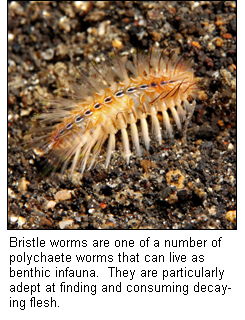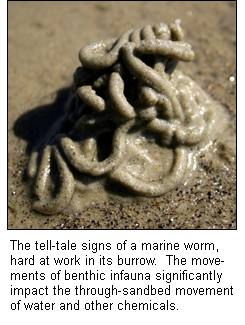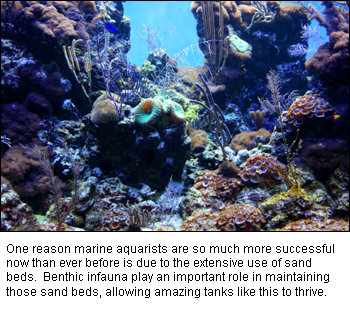Tips from the Pros: Seed a New Tank with Sand From an Established One

When cycling a new tank, there are as many opinions about how to do it as there are actual ways to do it. That means that there are really no right answers, just recommendations. Todays Tips From the Pros puts forth the suggestion that a good cupful of sand from the bottom of a well-established, well-maintained tank will kick off the life in a new aquarium with strength. The main concerns, importing pests and toxins with the old sand, are unfounded for the most part. The benefitthe introduction of benthic bacteria and infaunais a huge boost that largely outweighs the risk. Make a tank strong early, and it will stay stronger, longer.

Here is the deal: the sand bed of a healthy tank should be packed with benthic detritivores. Bacteria, algae, crustaceans, and worms all call the space between the grains home. These organisms are critical in both recycling waste material and moving waste down through depths of the sand. Essentially, the infauna consume extra food, feces, nitrogenous chemicals, and dead organisms. In so doing, each step of the benthic food chain sees a little bit more waste sequestered in a living cell. Eventually the chain is exhausted, but not before all the toxins have been consumed and converted into non-toxic nitrogen gas. Not shockingly, infauna are incredibly important to a healthy tank. The problem is that, on their own, they can take many months to populate the substrate. Using the sand from another healthy tank will dramatically speed up the process.
Many aquarists may be worried about importing some sort of pest with the new sand, which is an understandable concern. In truth, however, there is no way to avoid this problem. Though there may be a few species that are avoidable without much effort, organisms like Aiptaisia anemones, cyanobacteria, hair algae, and diatoms are all ubiquitous pests in the hobby. Unfortunately, the need to use authentic live rock to seed a tank makes it impossible not to have some or all of these pests. Theoretically, I suppose one could use synthetic live rock, dry sand, and bacterial supplements to get a tank going, but there would be no benthic infauna to facilitate waste cycling. You really need at least one piece of real live rock. Most likely, you will be using 100% real rock, and thus will already have introduced the pests you would otherwise want to avoid. Therefore, the concern of importation of pests when using sand from another tank may not be entirely substantiated.
The other primary concern is somewhat more founded. The potential exists to free toxins, like hydrogen sulfide, if a deep sand bed is disturbed. Though unlikely, this outcome is certainly possible. Fortunately, most display tanks do not present good conditions for the development of sulfides. Compared to deep sand beds, displays typically have better flow, courser sand, and larger animals moving around. The result is a more oxygenated substrate, top to bottom, which prevents the development of the anoxic conditions required to create hydrogen sulfide. Medium-fine sand taken from the top two inches of a main display tank therefore should give you no problem. Ideally, you want to mix some of this sand with some packaged live sand, which contains lots of bacteria, and spread it through the display. It is also a good idea to cover the sugar-fine sand/mud of a deep sand bed with an inch of the seeded sand.

Sand seeded with infaunal animals will really help advance the cycle of a new marine aquarium. Though aquarists often think about the cycling period as being predominated by bacterial colonization, the infaunal colonization is equally important for the long-term life of the tank. The organisms that live between the grains drastically speed up the processes that recycle poisonous nitrogenous waste, both by consumption and subsequent conversion, and by moving it down into the anoxic regions. The infauna, if not brought in with the sand, will have to move from your live rock to your sand. This migration may take months to complete, and it could be six months or more before the entire system is fully seeded. It makes sense, then, to try and speed up the process wherever possible. Using seeded sand may not enable you to put livestock into the tank immediately, but it will make your tank more stable by the time it is safe to introduce something else. The infaunal organisms are also accustomed to living in the varying water quality conditions that exist within a sand bed. They should therefore survive the dicey conditions of cycling the aquarium quite well. Any attrition that results from the introduction of the seeded sand simply adds to the nutrient stew that fuels the completion of the initial cycle.

Used judiciously, a good scoop of seeded sand from a well-maintained aquarium will give your new tank a leg-up on life. While it is advisable to choose the donating aquarium with care, the benefit of adding the sand far outstrips the chances of having a real problem. Find a tank you trust and use it as a tool to enhance your own new tank. The importance of the benthic infauna cannot be understated, and establishing them early is a key to the long-term viability of any marine system. The sand from a well-established aquarium should be chocked full of important infaunal organisms. In the old system, they will hardly be missed. In the new system, they will quickly spread out and colonize all the available habitat areas. Remember to add them to your deep sand bed as well, especially if your sump does not contain its own live rock. Strictly speaking, the infauna will spawn, and broadcast their offspring to all corners of the system. Again, however, it goes back to establishing solid colonies early. Adding the seeded sand to the top of the deep sand bed simply speeds the process along, and eliminates the need to wait for unpredictable spawning events.
Works Cited:
Hanley, C.J. The Dish on Sand Grain Size. Quality Marine Online. 2010. URL: http://www.qualitymarine.com/News/Feature-Articles/The-Dish-on-Sand-Grain-Size-%2806/14/10%29
Shimek, R.L. Dearest Mudder.... The Importance of Deep Sand. Aquarium Fish Magazine, Mar. 2001. Revised 2006. URL: http://www.ronshimek.com/deep_sand_beds.html
Shimek, R.L. How Sand Beds Really Work. Reefkeeping Online Magazine, June 2003. URL: http://reefkeeping.com/issues/2003-06/rs/feature/index.php